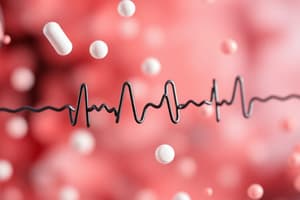Podcast
Questions and Answers
What is the most accurate description of drug distribution within the body?
What is the most accurate description of drug distribution within the body?
- Irreversible movement of the drug from the bloodstream to other areas.
- Process of irreversible transfer of the drug from the bloodstream to other areas.
- Reversible transfer of the drug from tissues back into the bloodstream.
- Process of reversible transfer of the drug from the bloodstream to other areas. (correct)
Which factor does NOT influence the rate and extent of drug distribution?
Which factor does NOT influence the rate and extent of drug distribution?
- The drug's elimination half-life. (correct)
- The permeability of tissue membranes to the drug.
- The degree of perfusion of organs and tissues.
- Binding of the drug to plasma proteins and tissue components.
Which patient characteristic might influence drug distribution?
Which patient characteristic might influence drug distribution?
- Eye color
- Height
- Shoe size
- Oedema (correct)
Based on blood flow, which organ would likely receive a drug more rapidly after systemic administration?
Based on blood flow, which organ would likely receive a drug more rapidly after systemic administration?
A drug distributes into tissues at approximately the same rate. What is this distribution pattern described as?
A drug distributes into tissues at approximately the same rate. What is this distribution pattern described as?
In a single-compartment model, what is assumed about the drug's dispersion?
In a single-compartment model, what is assumed about the drug's dispersion?
Which of the following tissues is considered highly perfused?
Which of the following tissues is considered highly perfused?
What is the primary distinction between the two-compartment and single-compartment distribution models?
What is the primary distinction between the two-compartment and single-compartment distribution models?
What characterizes the first compartment in a two-compartment model?
What characterizes the first compartment in a two-compartment model?
A drug demonstrates a volume of distribution (Vd) of 15 liters in a 70 kg adult. What does this indicate about the drug's distribution?
A drug demonstrates a volume of distribution (Vd) of 15 liters in a 70 kg adult. What does this indicate about the drug's distribution?
Which of the following influences the volume of distribution (Vd)?
Which of the following influences the volume of distribution (Vd)?
What does a large volume of distribution (Vd) suggest about a drug's properties?
What does a large volume of distribution (Vd) suggest about a drug's properties?
Which statement is true regarding protein-bound drugs?
Which statement is true regarding protein-bound drugs?
If drug D has a volume of distribution (Vd) of 510 L, where is it primarily located?
If drug D has a volume of distribution (Vd) of 510 L, where is it primarily located?
If a drug has similar concentrations in plasma and tissues, what volume of distribution (Vd) would be expected?
If a drug has similar concentrations in plasma and tissues, what volume of distribution (Vd) would be expected?
A 60-year-old male patient has a reduced kidney function. How will this impact the distribution of a hydrophilic drug?
A 60-year-old male patient has a reduced kidney function. How will this impact the distribution of a hydrophilic drug?
A drug is administered intravenously, and a blood sample is taken. The drug's concentration is high in the blood. What will happen to the drug's concentration in the blood as the drug distributes into the tissues?
A drug is administered intravenously, and a blood sample is taken. The drug's concentration is high in the blood. What will happen to the drug's concentration in the blood as the drug distributes into the tissues?
A new drug is developed that is highly lipophilic and has a strong affinity for adipose tissue. What effect would you anticipate with respect to its volume of distribution?
A new drug is developed that is highly lipophilic and has a strong affinity for adipose tissue. What effect would you anticipate with respect to its volume of distribution?
Which patient factor can influence drug distribution due to altered body composition?
Which patient factor can influence drug distribution due to altered body composition?
A drug with a volume of distribution close to total body water will distribute into what?
A drug with a volume of distribution close to total body water will distribute into what?
Flashcards
Drug Distribution
Drug Distribution
Reversible transfer of a drug from the bloodstream to other areas of the body.
Factors Affecting Distribution
Factors Affecting Distribution
The rate and extent of drug distribution is determined by organ perfusion, drug binding to plasma proteins and tissues, membrane permeability, ion trapping, P-glycoprotein, and pKa.
Compartments (Drugs)
Compartments (Drugs)
The sum of all tissues into which a drug distributes at approximately the same rate.
Single Compartment Model
Single Compartment Model
Signup and view all the flashcards
Two Compartment Model
Two Compartment Model
Signup and view all the flashcards
Volume of Distribution (Vd)
Volume of Distribution (Vd)
Signup and view all the flashcards
Large Vd Implies
Large Vd Implies
Signup and view all the flashcards
Small Vd Implies
Small Vd Implies
Signup and view all the flashcards
Vd and Body Size
Vd and Body Size
Signup and view all the flashcards
Study Notes
- Distribution is the reversible transfer of a drug from the bloodstream to other areas of the body.
- A drug is considered eliminated if it does not return to the blood.
- The rate and extent of drug distribution is determined by how well perfused the organs and tissues are.
- Other determining factors are the drug's binding to plasma proteins and tissue components, the permeability of tissue membranes to the drug, ion trapping, P-glycoprotein, and pKa.
Patient Characteristics Affecting Drug Distribution:
- Oedema and dehydration
- Weight loss and obesity
- Gender
- Age
- Ethnicity
Distribution in Relation to Blood Flow:
- Brain receives 15% of blood flow.
- Kidneys receive 22% of blood flow.
- Fat receives approximately 10% of blood flow.
- Muscle receives 15% of blood flow.
- Liver receives 6% of blood flow from systemic circulation and 21% from the gastrointestinal tract.
Compartments
- Compartments are the sum of all tissues into which a drug distributes at approximately the same rate.
Single Compartment
- All tissues are penetrated rapidly or not at all.
- Blood and all penetrated tissues (T1 & T2) are combined as a single compartment.
- The drug is assumed to spread 'instantly' throughout the single compartment.
Blood Flow Rates (mL/min/g):
- Lung: 10 (Highly perfused)
- Kidney: 4 (Highly perfused)
- Liver: 0.8 (Highly perfused)
- Brain: 0.5 (Highly perfused)
- Fat: 0.03 (Poorly perfused)
- Muscle: 0.025 (Poorly perfused)
- Bone: 0.02 (Poorly perfused)
Two Compartments
- A drug penetrates some tissues rapidly and others slowly.
- Blood and rapid tissues (T1 & T2) are combined as the first compartment.
- The drug spreads 'instantly' through the first compartment.
- Slow tissues (T3 & T4) are combined as the second compartment.
Volume of Distribution
- Volume of distribution is the apparent volume of fluid that would be required to contain the drug in the body at the same concentration as in the blood or plasma.
- Drugs may distribute into plasma (4 litres).
- Drugs may distribute into interstitial fluid (10 litres).
- Drugs may distribute into intracellular fluid (28 litres).
- Volume of distribution is a convenient method for describing how well a drug is removed from the plasma and distributed to the tissues.
- A large volume of distribution means wide distribution or extensive tissue binding, or both.
- Protein-bound drugs trapped in plasma will have small volumes of distribution.
- C = D/Vd, representing concentration equals dose divided by volume of distribution.
- Vd = D/C, representing volume of distribution equals dose divided by concentration.
Volume of Distribution Examples for a 70 Kg Adult
- Warfarin: 7 litres (Small volume, mainly stays in plasma, little in tissues)
- Gentamicin: 16 litres
- Theophylline: 35 litres
- Cimetidine: 140 litres (Medium volume, similar concentrations in plasma and tissues)
- Digoxin: 510 litres
- Mianserin: 910 litres (Large volume, mainly in tissues, little in plasma)
- Quinacrine: 50,000 litres
- Volume of distribution depends on body size.
Practice Question and Solution
- Problem: A 50mg dose of analgesic is administered intravenously, and a blood sample taken shortly afterwards shows an initial concentration of 0.85 µg/mL. Calculate the volume of distribution in litres.
- Solution:
- Vd = D/C
- Vd = 50mg / 0.85µg/mL
- Vd = 50,000µg / 0.85µg/mL
- Vd = 58,824mL
- Vd = 59 litres
Studying That Suits You
Use AI to generate personalized quizzes and flashcards to suit your learning preferences.





